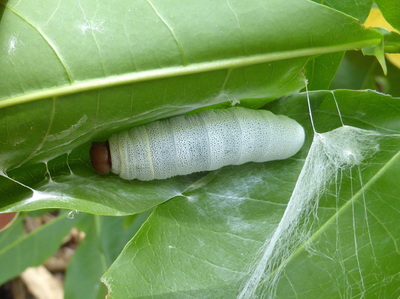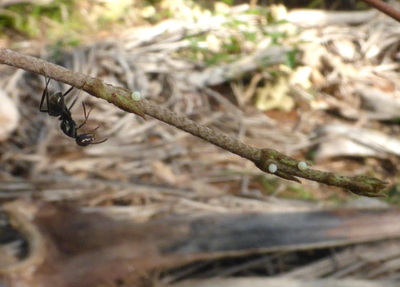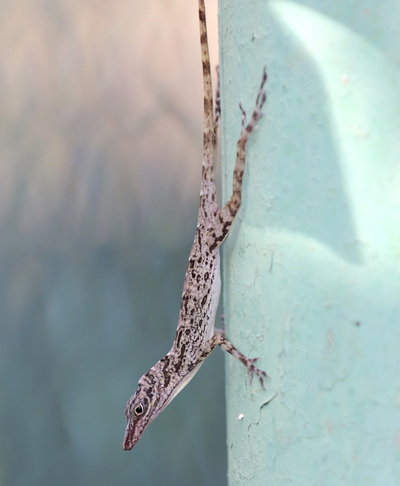While Doug and I went exploring Lynn talked to Roebis the gardener who was a geography graduate. He spoke good English and Lynn gave him a dictionary and some books and crayons for his children. She then sat and drank liquorice tea with Leandro while we were butterflying around the hotel. Leandro told her that he had loved butterflies as a child but when 11 he had hurt his leg badly while chasing them - and still has the two scars to prove it.
|
Villa Maguana is situated 22km west of Baracoa and has a small number of two story villa blocks situated right next to a lovely beach. No swimming pool full of green slime here! Just the beautiful warm Caribbean. This was not the high season and the hotel was quiet. Lynn chatted with a lady from Argentina who had taught English there and had visited England many times. She and her husband who were driving themselves across Cuba back to Havana were the only other people staying at hotel. While Doug and I went exploring Lynn talked to Roebis the gardener who was a geography graduate. He spoke good English and Lynn gave him a dictionary and some books and crayons for his children. She then sat and drank liquorice tea with Leandro while we were butterflying around the hotel. Leandro told her that he had loved butterflies as a child but when 11 he had hurt his leg badly while chasing them - and still has the two scars to prove it. There were a few butterflies in the garden but the adjacent fenced area looked even more promising and we found we could access it by going around the end of the fence by the beach. It turned out to be a small coconut plantation with scattered low scrub and we straight away started finding some interesting things. First were some larval shelters of May's Skipper Proteides maysi. Unfortunately there were no larvae - presumably all predated. There are 55 species of skipper in Cuba so plenty to keep up the interest and always new things to learn, well for us anyway. Doug showed us a couple of final instar larvae of Mangrove Skipper Phocides pigmalion feeding on Melicoccus bijugatus. This is a distinctive plant with its dark green leaves and and winged petioles. It is a member of the Sapindaceae rather than a mangrove Rhizophora. I'm always amazed how much larvae vary from one instar to the next. Take a look at the highlighted species page above to see how much the final instar varies from earlier instars. There was also a Monk Skipper Asbolis capucinus larva hiding under the turned down edges of a palm frond. There are about 3,500 species of skippers world-wide in the family Hesperiidae. This is currently split into seven sub-familes of which three are found in Cuba - the Hesperiinae feeding on Monocots eg grasses, palms and lily-type plants, and the other two feeding on Dicots, the Eudaminae which include the tailed skippers and generally hold their wings half open when settled and the Pyrginae which are also known as the spread-winged skippers that hold their wings flat when settled. There are only two skipper species whose larvae feed on palms in Cuba, the other being the Caribbean Skipper Pyrrhocalles antiqua. Both make similar shelters in palm fronds so you need to open them to see the larva which on A. capucinus (below) has a plain head and on P. antiqua has several narrow vertical black lines. I watched a female Miami Blue Cyclargus thomasi inspecting a Stigmaphyllon leaf that already had two eggs laid on the upper surface. On another shoot of the same plant were three eggs of Florida Duskywing Ephyriades brunnea but its eggs are much more dome-shaped compared to C. thomasi. It was interesting to watch the ant seemingly checking on these eggs - I wonder if the larvae would be at risk from the ant unlike the thomasi larvae which I watched being attended by what appeared to be the same ant species on the same plant as it fed on the sweet droplets exuded by the larva. Shame about the rubbish picture but I had the camera on the wrong settings! Doug then found a Whitish Yellow Pyrisitia messalina larva and pupa! And then followed that up by finding two pre-pupae of Atala Hairstreak Eumaeus atala and then a couple of adults. This butterfly is quite unlike any other Hairstreaks and in fact could be confused with a similar-coloured moth. After lunch we went a short distance along the road to the east and, after finding another Anolis species that I can't yet identify next to the road, we spent some time photographing Cornelius Skipper Euphyes cornelius and Singularis Skipper Euphyes singularis along the wayleave of the power cables. I also managed my first half-decent shots of De Villiers' Swallowtail Battus devilliers.
1 Comment
|
Welcome to our Blog
Here we will post interesting news about what we and others have seen in Cuba. Archives
July 2024
Categories |





















 RSS Feed
RSS Feed